Marsabit is home to many birds that occupy the area’s diverse habitats. From the lush green forests to the dry shrublands and wetlands, birds from around the world come to Marsabit to feed, breed, and rest.
With over 450 species of birds recorded in the region, the area provides a unique opportunity to observe and study the rich diversity of birds that inhabit the area.
From the iconic ostrich to the majestic Verreaux’s eagle, Marsabit is home to many species, some of which are endemic to the region. This area is an ornithologist’s paradise, from the colorful bee-eaters to the majestic crowned cranes.
Marsabit is an ideal destination for birdwatchers and nature lovers with its diverse habitats, unique species, and stunning landscapes.
15 Birds to Watch in Marsabit
Marsabit is a county in northern Kenya that is home to a rich diversity of wildlife, including some of the most beautiful and rare birds in Africa.
If you are a bird lover, you will not want to miss the opportunity to visit this amazing destination and see some of the feathered wonders that inhabit its forests, lakes, and mountains.
Here are 15 birds that you should look out for when you travel to Marsabit.
1. Little Grebe
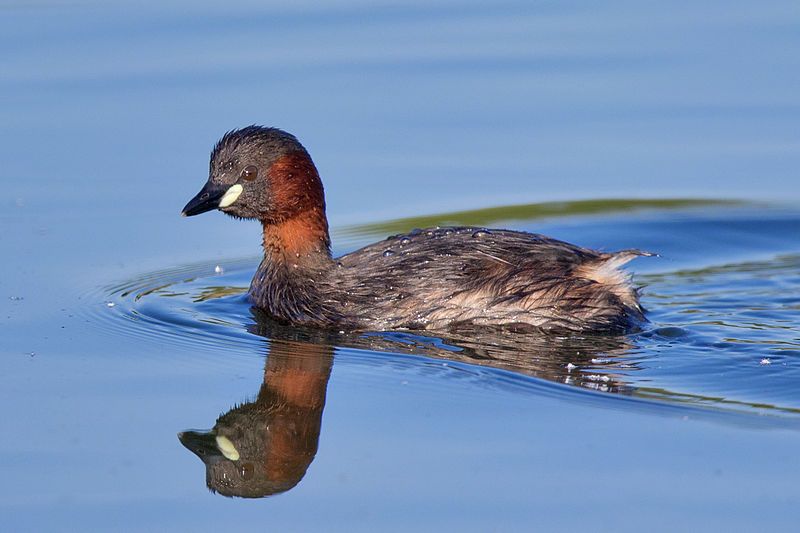
The little grebe, also known as dabchick, is a small water bird belonging to the Grebe family. Its scientific name is derived from Ancient Greek and Latin words.
The genus name, thus, comes from the Ancient Greek word meaning “fast,” as this bird is known for its quick movements in the water.
The specific name, ruficollis, combines two Latin words, Rufus, meaning “red,” and Collis, meaning “necked.” This is because the little grebe has a reddish neck.
This bird is well adapted to life in the water, and its name in Latin translates roughly to “fast sinks under,” which is an apt description of its fish-catching behavior.
| Kingdom | Animalia |
| Phylum | Chordata |
| Class | Aves |
| Order | Podicipediformes |
| Family | Podicipedidae |
| Genus | Tachybaptus |
| Species | T. ruficollis |
2. Hartlaub’s Turaco
Hartlaub’s turaco is a species of bird that is part of the family Musophagidae. This species of bird is native to the countries of Kenya, Tanzania, and Uganda. The common name of this bird species pays tribute to the German physician and ornithologist Gustav Hartlaub.
The Latin binomial of the species is also named in honor of Hartlaub. Hartlaub was an influential figure in ornithology, and his name is a fitting tribute to this bird species.
He was active in the field of ornithology in the 19th century and the naming of this species of bird recognized his contributions to the field. It is a reminder of the importance of his work and the impact he had on the field of ornithology.
| Kingdom | Animalia |
| Phylum | Chordata |
| Class | Aves |
| Order | Musophagiformes |
| Family | Musophagidae |
| Genus | Tauraco |
| Species | T. hartlaubi |
3. Emerald-spotted Wood Dove
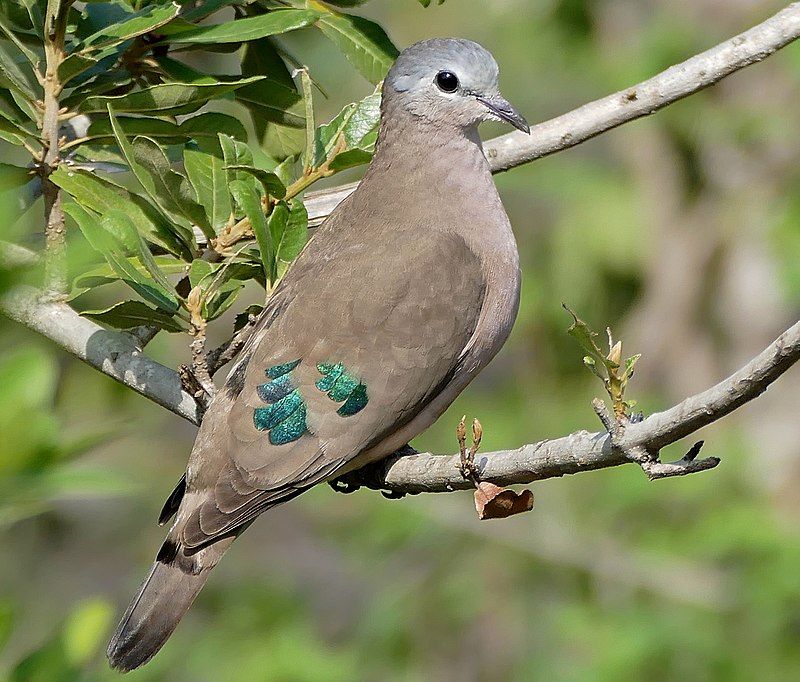
The emerald-spotted wood dove is a member of the Columbidae family of birds and is found mainly in Africa’s eastern and southern regions.
It prefers drier deciduous woodlands and second-growth habitats, such as those that are open and have been recently disturbed by human interference.
This species is not typically found in evergreen rainforests or semi-desert areas. The emerald-spotted wood dove has a distinct plumage with emerald-green spots on its feathers.
It is a small bird typically found in pairs or small groups, foraging for food on the forest floor.
They are known to feed on various seeds and small fruits, as well as insects and other invertebrates. The emerald-spotted wood dove is considered the least concerning by the International Union for Conservation of Nature.
However, its population is decreasing due to habitat loss and human interference. It is essential to conserve the habitats of this species to ensure its population remains stable and healthy.
| Kingdom | Animalia |
| Phylum | Chordata |
| Class | Aves |
| Order | Columbiformes |
| Family | Columbidae |
| Genus | Turtur |
| Species | T. chalcospilos |
4. African Olive Pigeon
The African olive pigeon, also known as the Rameron pigeon, is a species of pigeon found across much of eastern and southern Africa, ranging from Ethiopia to the Cape.
This pigeon species is a resident breeding bird, meaning it lives and breeds in the same area year-round. It is also found in western Angola, southwestern Saudi Arabia, and northern Yemen, giving it a wide range.
African olive pigeons are a gray-brown color with a similar gray-brown head and neck and a red bill and eye ring. They are known for their white chest, belly, and white-tipped tail.
The African olive pigeon is a medium-sized bird that feeds mainly on fruits, seeds, and buds. They are often found in large flocks, which helps them to stay safe from predators. African olive pigeons have a long history of domestication and can be kept as pets.
They are also hunted for their meat, a delicacy in some parts of Africa.
| Kingdom | Animalia |
| Phylum | Chordata |
| Class | Aves |
| Order | Columbiformes |
| Family | Columbidae |
| Genus | Columba |
| Species | C. arquatrix |
5. Grey Crowned Crane
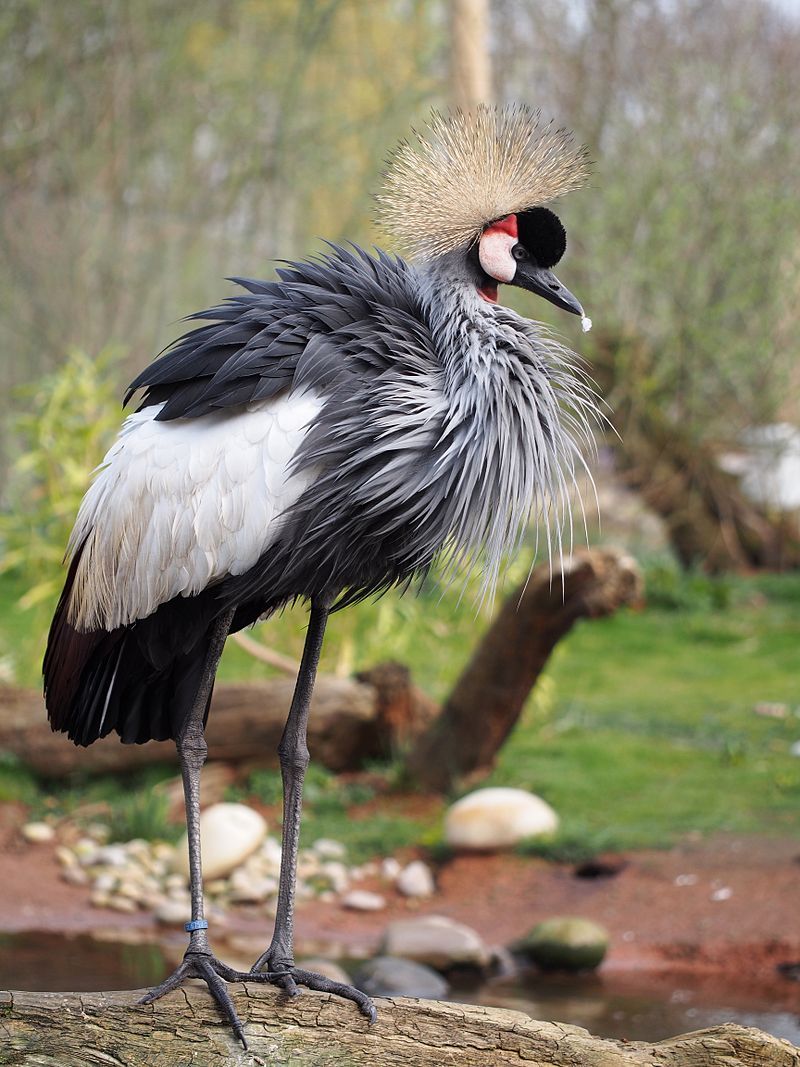
The grey-crowned crane is a species of bird that is found in Africa. It is part of the crane family, Gruidae. It is characterized by its grey crown of feathers and is known by many names.
It is referred to as the African crowned crane, golden crested crane, golden-crowned crane, East African crane, East African crowned crane, African crane, Eastern crowned crane, Kavirondo crane, South African crane, and crested crane.
The grey-crowned crane is a large bird, standing up to 1.5 meters tall and having a wingspan of up to 2 meters. It is primarily a white bird with a grey crown, a red patch of feathers on its head, and a black beak. Its legs are black, and its wings are black with white tips.
It has a long tail with a white plume at the end. The grey-crowned crane is a social bird, often found in flocks of up to 25 individuals. It feeds mainly on plants, seeds, insects, and small animals.
It is an omnivorous species, consuming both plant and animal matter. It has a loud call that can be heard from long distances. The grey-crowned crane is an essential species in the African ecosystem.
It symbolizes luck and peace in many African cultures and is a protected species in many countries. This species is also threatened by the destruction of its natural habitats, such as wetlands, due to human activities.
| Kingdom | Animalia |
| Phylum | Chordata |
| Class | Aves |
| Order | Gruiformes |
| Family | Gruidae |
| Genus | Balearica |
| Species | B. regulorum |
6. Speckled Pigeon
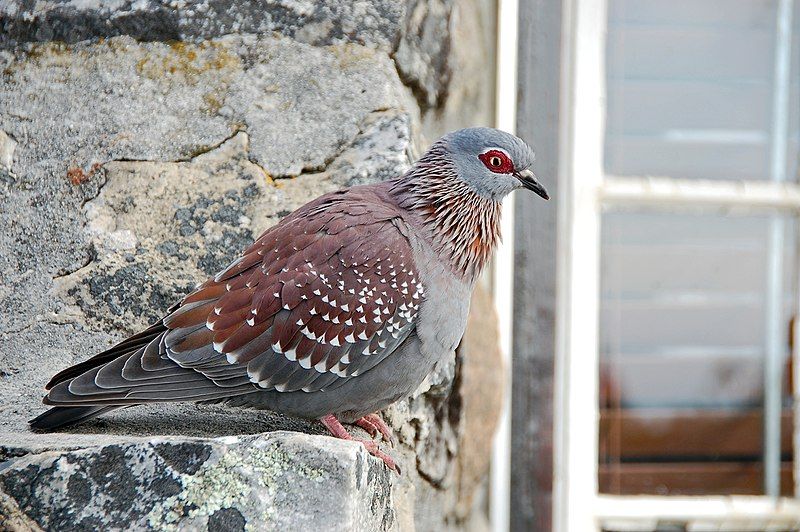
The speckled pigeon, also known as the African rock pigeon or Guinea pigeon, is a bird commonly found in Africa south of the Sahara. It is a species found in a variety of open habitats, and it is a widespread species in these areas.
However, there are also certain regions where the speckled pigeon is not found, leaving gaps in its distribution. As a resident breeding bird in these habitats, the speckled pigeon is an integral part of the African ecosystem.
The speckled pigeon is easily identified by its gray feathers, giving it a unique look compared to other pigeons. Additionally, it has a distinctive white patch on its wings, and its head is usually a light gray.
It is a medium-sized bird, usually reaching lengths of around 30 centimeters. The speckled pigeon is an omnivorous bird, with its diet consisting of various plant materials, seeds, and insects.
It has also been known to feed on carrion, making it an essential environmental scavenger. As a result, it helps to keep the environment clean by breaking down organic matter. The speckled pigeon is monogamous, meaning that it mates for life.
The female will lay a single clutch of usually two eggs in a nest, which are incubated for 18 days. The young chicks are cared for by both parents until they are old enough to leave the nest.
The speckled pigeon is a widespread species in open habitats across much of Africa south of the Sahara. Despite the gaps in its distribution, it is an integral part of the ecosystem, providing food for other animals and helping to break down organic matter.
| Kingdom | Animalia |
| Phylum | Chordata |
| Class | Aves |
| Order | Columbiformes |
| Family | Columbidae |
| Genus | Columba |
| Species | C. guinea |
7. Kori Bustard
The kori bustard is an impressive bird found in the African continent. It is the giant flying bird native to the region, as it belongs to the bustard family and is known for its large size.
This family of birds is part of the order Otidiformes and is exclusive to the Old World. It is one of four species that form the genus Ardeotis, a group of large-bodied birds.
The kori bustard primarily inhabits African savannas and grasslands and is easily recognizable due to its size and unique coloration. It has a large, grayish-brown body with white patches, a long neck, and a robust and wedge-shaped tail.
It is a ground-dwelling bird and feeds mainly on seeds, fruits, and small animals. It can also fly but is not particularly good at it. The kori bustard is a solitary bird usually seen alone, although it may sometimes join a flock of smaller birds.
It is also a vocal bird, with its loud, low-pitched call being one of its most distinctive features. It is also known to perform elaborate courtship displays to attract a mate. This involves stretching its wings and tail and then running with its wings spread wide.
The kori bustard is a fascinating bird and is an essential species in the African environment. It is currently listed as vulnerable on the IUCN Red List due to habitat loss and overhunting.
Conservation efforts are underway to protect this majestic bird and ensure its survival.
| Kingdom | Animalia |
| Phylum | Chordata |
| Class | Aves |
| Order | Otidiformes |
| Family | Otididae |
| Genus | Ardeotis |
| Species | A. kori |
8. Somali Ostrich
The Somali ostrich is a large and fascinating bird native to the Horn of Africa. It is one of two species of ostriches globally, the other being the common ostrich.
It was previously considered a subspecies of the common ostrich but was identified as its unique species in 2014. This species of ostrich is also known as the blue-necked ostrich due to its distinctive blue-neck feathers.
The Somali ostrich is a flightless bird, meaning they cannot fly. They are the largest living bird species and can reach heights of up to 2.7 meters tall. Its feathers are greyish-brown, and its neck is deep blue with white bars in the middle.
The Somali ostrich is typically found in open habitats such as the savannah but can also live in more arid conditions. The Somali ostrich is an herbivore, which feeds mainly on plant matter such as leaves, fruits, and roots.
It will also occasionally eat insects and small lizards. The Somali ostrich prefers to feed during the day but can also be seen foraging at night. The Somali ostrich is a social bird, typically living in groups of up to 20 individuals.
They are also very territorial and will defend their territory against any intruders.
To attract potential mates, the males will display their colorful plumage and perform a courtship dance. The Somali ostrich is an excellent and unique bird found only in the Horn of Africa.
It is an integral part of the local ecosystem and is a species that should be protected and preserved.
| Kingdom | Animalia |
| Phylum | Chordata |
| Class | Aves |
| Order | Struthioniformes |
| Family | Struthionidae |
| Genus | Struthio |
| Species | S. molybdophanes |
9. Bearded Vulture
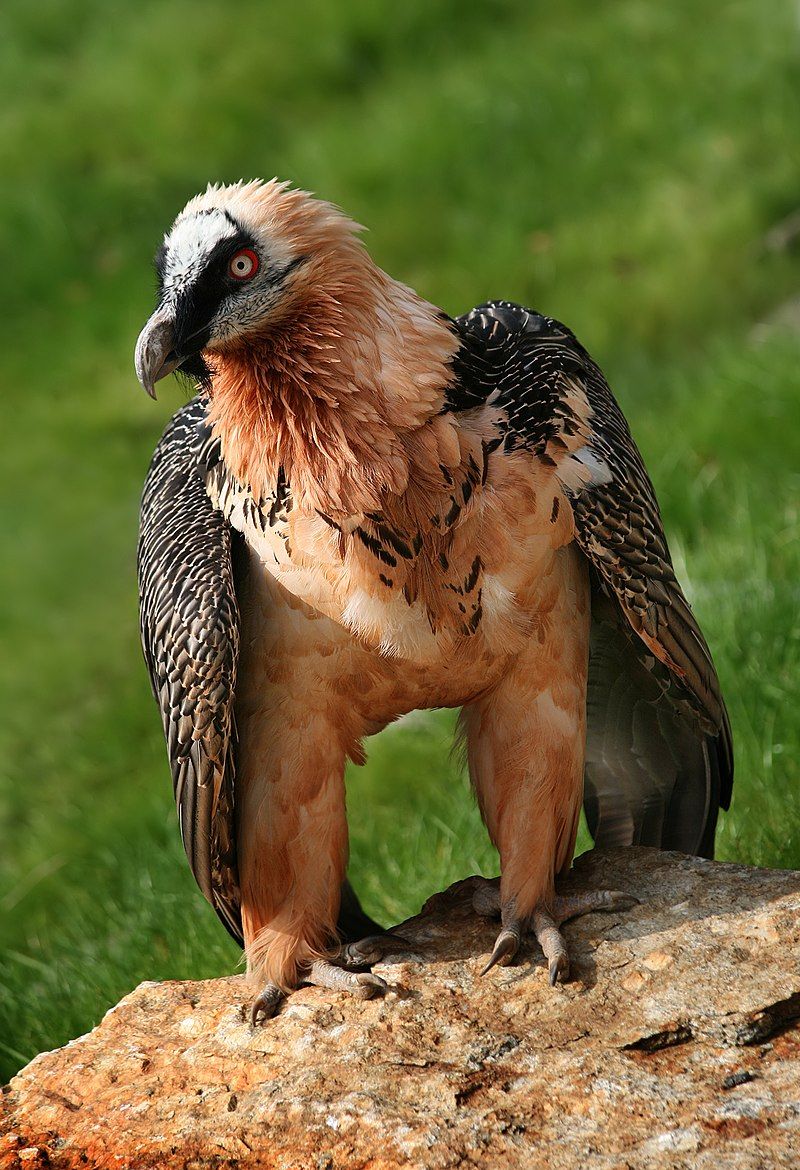
The bearded vulture is a large bird of prey that belongs to the Accipitridae family. It is the only bird of its genus, Gypaetus, known as the lammergeier or ossifrage.
It is traditionally considered an Old World vulture but is more closely related to the Egyptian vulture than other Old World vultures.
This has led to its minor lineage, making it a unique species among its family. The bearded vulture is a huge bird with a wingspan of up to 2.5 meters and a weight of up to 7 kg. It is mainly found in Europe, Africa, and Asia mountainous regions.
It is a scavenger and feeds mainly on carcasses of dead animals, including bones. It is known to drop bones from great heights to break them open and access the marrow inside.
This behavior, along with its distinctive white head and neck feathers, has earned it the nickname of “bone-breaker.”The bearded vulture is a solitary bird, usually seen alone or in pairs. It is a long-lived species, with some living for up to 50 years.
It is listed as near-threatened by the IUCN, with the main threats being habitat loss and degradation of its habitat. Conservation efforts are underway to protect the species and its habitat.
| Kingdom | Animalia |
| Phylum | Chordata |
| Class | Aves |
| Order | Accipitriformes |
| Family | Accipitridae |
| Genus | Gypaetus |
| Species | G. barbatus |
10. Vulturine Guineafowl
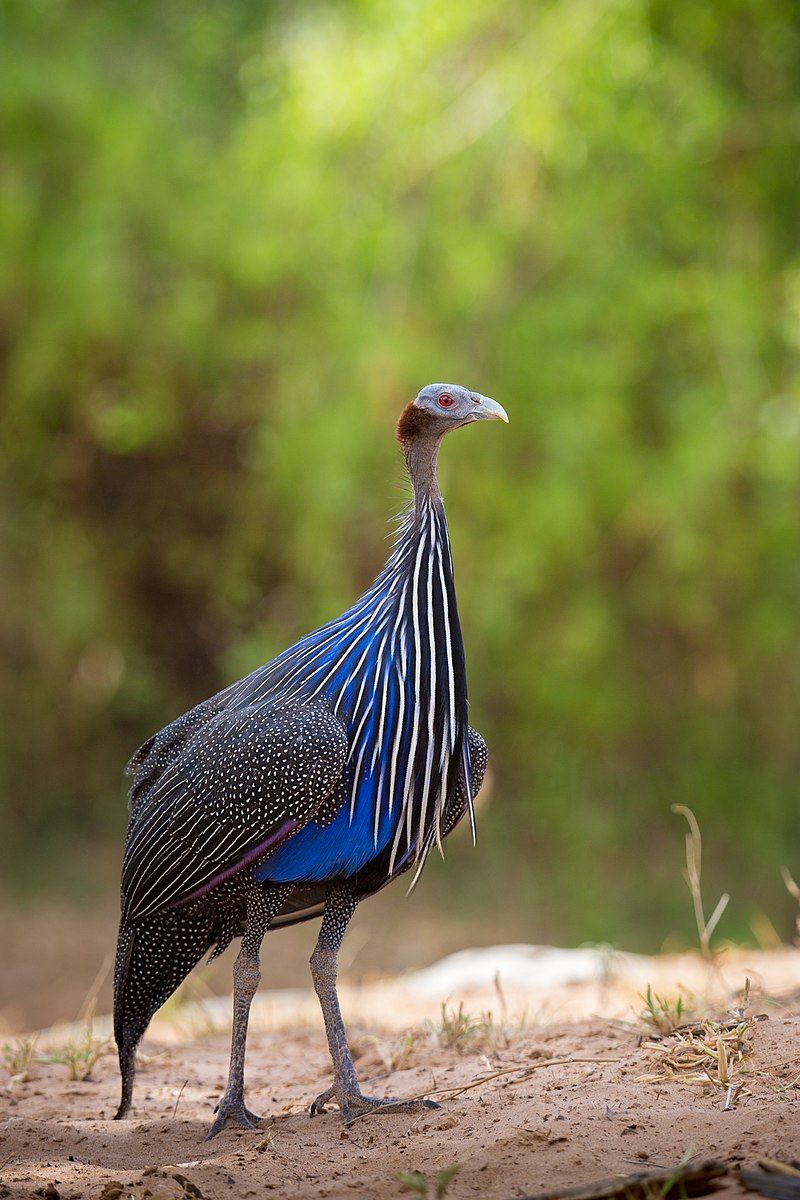
The vulturine guineafowl is the largest species of guineafowl that currently exists. It is not closely related to other guineafowl species, but it shares some common characteristics with them.
Its closest living relative is the white-breasted guineafowl, which is found in the primary forests of Central Africa. This particular species of guineafowl is known for its large size, distinctive black and white feathers, and long tail.
It is also known for its loud call, often heard in the early morning and late evening. The vulturine guineafowl is an integral part of the ecosystem in Central Africa, as it helps to control the population of various insects and other pests.
It is also an essential part of the culture, as it is often hunted for its feathers and meat used in traditional ceremonies and rituals.
| Kingdom | Animalia |
| Phylum | Chordata |
| Class | Aves |
| Order | Galliformes |
| Family | Numididae |
| Genus | Acryllium |
| Species | A. vulturinum |
11. Southern Pochard
The southern pochard is a species of duck belonging to the genus Netta. It is found in two distinct subspecies, the South American pochard (N. e. erythrophthalma) and the African pochard (N. e. brunnea).
The South American pochard is found in Paraguay, Bolivia, Argentina, and Uruguay. The African pochard is found in Ethiopia, Kenya, Somalia, and Sudan. Both subspecies have similar characteristics, including a gray-brown body and yellow-orange eyes.
The African pochard, however, has a distinctive white patch on its forehead, while the South American pochard does not. The southern pochard is an omnivore, meaning it feeds on plant and animal matter.
Its diet includes seeds, insects, small fish, and aquatic plants. The bird is known to dive for its food and can stay underwater for several minutes.
This species is known to congregate in large flocks, often numbering in the thousands, and is known to migrate during the winter months.
The southern pochard is an essential species in its habitat, as it helps to disperse the seeds and nutrients from aquatic plants throughout its range.
Unfortunately, the southern pochard is facing significant population declines due to hunting, habitat destruction, and the introduction of invasive species. Conservation efforts are underway to protect the species and ensure its continued survival.
| Kingdom | Animalia |
| Phylum | Chordata |
| Class | Aves |
| Order | Anseriformes |
| Family | Anatidae |
| Genus | Netta |
| Species | N. erythrophthalma |
12. Heuglin’s Bustard
Heuglin’s bustard is a species of bird that belongs to the bustard family. This species is a large bird found in the grasslands and savannahs of Africa. The bird is named after Theodor von Heuglin, a German explorer who discovered the species in 1862.
Heuglin’s bustard is characterized by its dark brown and grey plumage and white underside. They have a long tail and neck, with a body length ranging from 65 to 80 centimeters. They feed mainly on insects, seeds, and other small animals.
During the breeding season, males perform a mating ritual of displaying their feathers and strutting around to attract females. The female builds the nest and lays two to four eggs clutch.
Heuglin’s bustard is a vulnerable species due to hunting and habitat loss. Conservation efforts are being made to protect this species and its habitat.
| Kingdom | Animalia |
| Phylum | Chordata |
| Class | Aves |
| Order | Otidiformes |
| Family | Otididae |
| Genus | Neotis |
| Species | N. heuglinii |
13. Masked lark
The masked lark is a lark species belonging to the family Alaudidae. It is a bird that is endemic to Ethiopia and Kenya. Its natural habitats are in areas of dry shrubland and dry lowland grasslands.
These areas tend to have a subtropical or tropical climate, making them ideal homes for the masked lark.
The lark cane in these dry climates because it can find shelter in shrubs and grasses and can find the form of insects, seeds, and small invertebrates.
In addition, the masked lark is well adapted to flying in tropical and subtropical regions’ dry and warm air. It can also migrate to different habitats to find food during times of the year when food is scarce.
The masked lark is an essential species in the ecosystems of Ethiopia and Kenya, helping to keep the balance of nature.
| Kingdom | Animalia |
| Phylum | Chordata |
| Class | Aves |
| Order | Passeriformes |
| Family | Alaudidae |
| Genus | Spizocorys |
| Species | S. personata |
14. Chestnut-bellied Sandgrouse
The chestnut-bellied sandgrouse, also known as the common sandgrouse, is a type of bird species found in many areas worldwide.
It is a sedentary species, which means that it lives in the same area for most of the year, and is also nomadic, meaning that it will often migrate to different regions in search of food or better habitat.
The chestnut-bellied sandgrouse is found in northern and central Africa and extends further east towards western and southern Asia.
There are six distinct variations within the species, known as subspecies, which are recognizable by their physical characteristics such as size, color, and other features.
The chestnut-bellied sandgrouse is an exciting species in many parts of the world.
| Kingdom | Animalia |
| Phylum | Chordata |
| Class | Aves |
| Order | Pterocliformes |
| Family | Pteroclidae |
| Genus | Pterocles |
| Species | P. exustus |
15. Somali Sparrow
The Somali sparrow is a species of bird found in Somalia, Djibouti, Ethiopia, and Kenya. It is a member of the family Passeridae, which includes other species of sparrows, such as the house sparrow and the Eurasian tree sparrow.
The Somali sparrow is part of a superspecies, a group of closely related species that can interbreed and produce viable offspring. The other species in this superspecies is the russet sparrow, and the two species are sometimes considered the same.
The Somali sparrow is a small bird, typically 15-17 cm long. It is mainly greyish-brown, with darker upperparts and white underparts. It has a distinctive facial pattern: a grey crown, white cheeks, and a dark eyestripe.
The Somali sparrow is an omnivore, feeding mainly on insects, seeds, and grains. It is usually found in open woodlands and grasslands and can often be seen foraging on the ground or in trees. The species is not considered to be threatened, and its population is stable.
| Kingdom | Animalia |
| Phylum | Chordata |
| Class | Aves |
| Order | Passeriformes |
| Family | Passeridae |
| Genus | Passer |
| Species | P. castanopterus |
Conclusion
Birds in Marsabit are diverse and vital to the local ecology. They provide essential ecosystem services, such as pest control, pollination, and seed dispersal. They also contribute to the local economy through tourism and hunting activities.
However, these birds face various threats, including habitat destruction, climate change, and overexploitation.
To ensure that these birds continue to thrive in Marsabit, conservation efforts must be focused on protecting their habitats and preventing further exploitation.